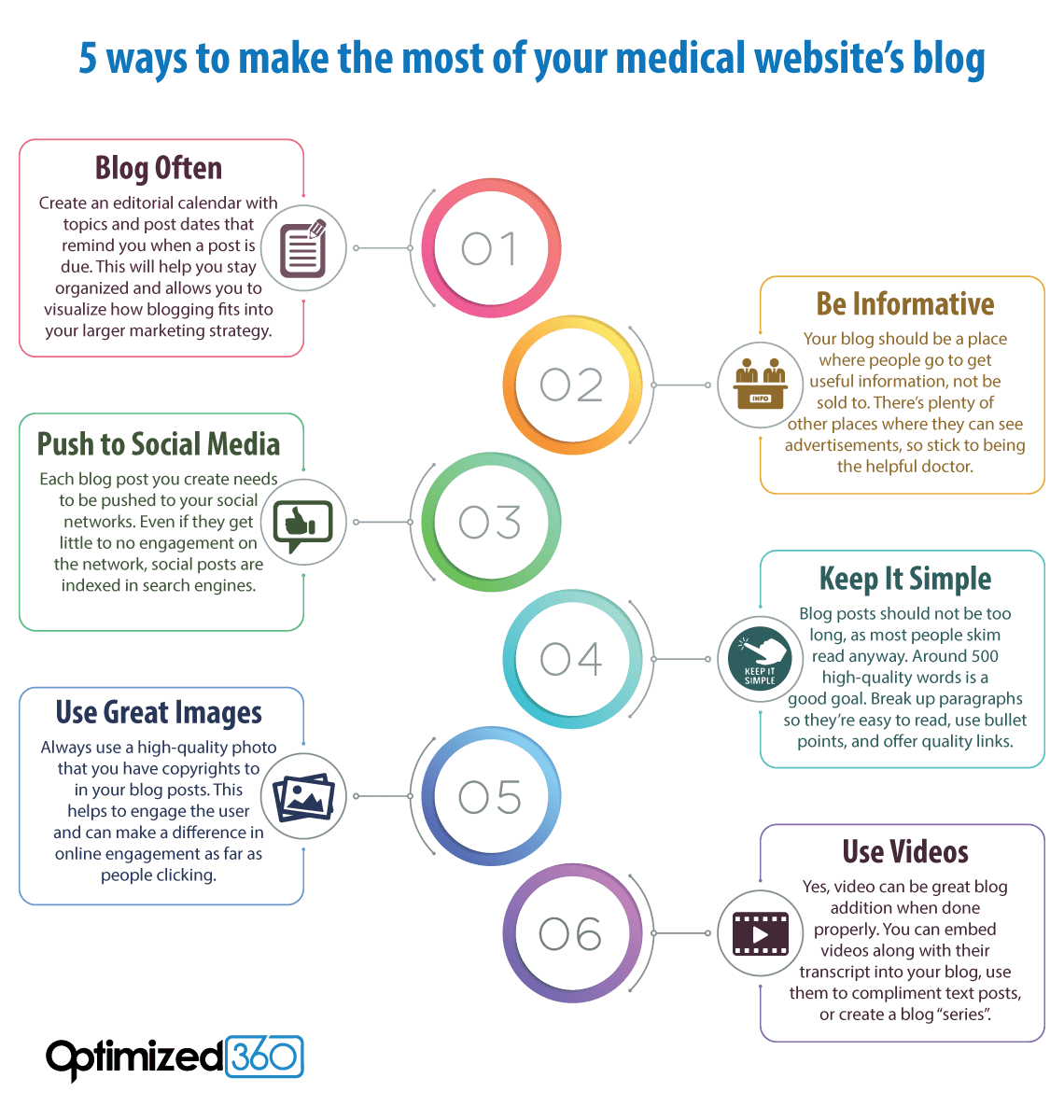A guide on what and how to write medical blogs so that patients and search engines notice you.
Most people have heard of search engine optimization (SEO). They understand how important it is for online search rankings. One key part of the ranking is the number of keywords on your website.
This matters when search engine robots visit your site. These digital vagabonds crawl through the internet to determine which sites will receive rankings. Getting top marks from them involves more than just using the right keywords.
To gain their approval, you must use the keywords effectively, in the right volume, and in the right places. Your website features a primarily static design that designers intend to change slowly, if at all. Your website’s medical blog will provide pieces of content with the dynamic nature needed to ensure it always reads as fresh content.
When healthcare professionals design their medical blogs, they often incorporate key phrases that people might be searching for. Some examples for general practitioners may include “annual physical,” “pain in legs,” and “colonoscopy.”

These are all examples of common issues that people may seek a doctor for. While these terms might not fit well into typical pages on your website, they fit exceptionally well into medical blogs. Furthermore, users can use them more than once without sounding like spam.
Blogs are important because they allow doctors to control the message on their websites. They are also a type of content that is an important part of a content marketing plan.
Five principles should be followed when writing a medical blog:
- Be informative.
- Keep it simple.
- Use great images.
- Add videos.
- Blog often.
- Share on social media.

Example
I hope you notice that this exceptional blog post incorporates all the above tips. We strive to post 3-5 times per week on the relevant subjects our clients and future clients may find interesting. We weave this sort of blogging into our marketing strategy and tactics. Our skilled team creates well-written content designed for your readers and the specific topics they search for online.

How do you make your medical blog effective?
- Offer a solution to your visitor’s problem. Your influence can extend beyond just showing great medical services. Consistently posting helpful content helps you to earn their trust as somebody who knows how to address those needs. This trust helps drive conversion rates of readers to patients.
- Develop a great title that highlights your medical blog post idea. Your blog title is the first thing visitors will find when looking for information. When you start writing, write a blog post in clear, precise language to avoid confusion.
- Keep your blog title concise and readable. Limit it to 6 or 8 words so the entire title appears in search results. Remember to include a strong call to action. Your medical blog has one main goal: attracting traffic to grow your practice.
After reading your posts, let your visitor explore the conversation further. The main goal is to get visitors to make an appointment.
However, you should also offer them other ways to connect with your office and share their information.
Readers may not be quite ready to make an appointment. That is why you should also allow readers to sign up for your email list or subscribe to your blog to receive updates.
- Think like the search engines.
Blogging in a format that resembles how people ask and answer questions makes great sense. This is probably one of the primary reasons you’re reading this article now. Prospective patients use search engines like Google to seek answers to their issues.
The purpose of these search engines is to help readers find the information they’re looking for. This often leads to search terms in the form of questions. Drive your digital marketing by considering what search queries you’d use when searching for a medical blog on this topic.
How to Write Well?

Writing good web content is difficult, whether you’re a natural writer or not. Writing marketing content that will help you rank higher is particularly challenging.
Of course, you could opt to do it yourself. But this choice often leads to the situation we discussed earlier. It results in an abandoned medical blog that began with good intentions but went nowhere. Writing blog content can be as dangerous as working on your medical website design.
The easiest option and one that will be most successful is to hire someone. You can guide them and help them find questions your patients ask you often, but you will leave it to them to write and publish the medical blogs.
If brainstorming topics, doing keyword research, writing content, and finding photos feel overwhelming, consider hiring a web marketing agency. This can help ensure your blog’s success.
How Often Should You Write?
We get this question tossed at us quite often. Our answer may be surprising.
Blogs written by healthcare professionals are tremendously popular. How do we know?
Google shares this information with us in two ways. First, it shows how it ranks blogs in its search engine. Second, it tells us the number of visits to different medical blog pages on our website and our clients’ websites.

The magic number for blogging frequency is maybe twice a week. In short, more blogging means more traffic and potential new patients for your dental or medical practice. Here are some relevant facts:
- Many marketers saw a 45 percent rise in web traffic when their blog posts increased from 11-20 to 21-50.
- Lead generation also benefits from regular blogging activity. When the frequency of blog posts increased from once to twice a week, the number of leads nearly doubled.
- The next significant increase comes from daily blogging, doubling your traffic.
- One significant downside of daily blogging is that each post only stays at the top for one day. If you blog twice a week, each post gets more attention by being in that top spot longer.
- Another problem with daily blogging is burnout. The pressure to keep producing can lead to lower-quality posts.
Posting a blog twice a week seems to be the best answer. However, weekly blogging can also be acceptable for most specialties.
How to Share Your Medical Blog on Social Media
Once your blog post is published on your website, take that extra step and push it over to your social media sites. You’ll see higher website traffic and an improvement in search engine rankings. Some of the most effective ways to promote your blog posts include:
- It’s key to consistently creating great content. Your readers will want to share informative, relevant, and sometimes even provocative content.
- Make sure that your social sharing buttons are visible. Many sharing buttons are often found at the top of the blog. However, placing them at the end of the blog is another option that works just as well.
- An important part of getting readers to share your content is asking them to do so. Website visitors often easily share information they find useful; it just takes a little prompting.
How long should a good blog post be?
Blog post length matters because it correlates strongly to higher rankings in search engines. This balance has existed for years. However, recent evidence shows that longer posts are more important for good search ranking. Although that is assuming the medical blog is full of useful content and comprehensive, not just long.
Google tries to rank the highest-quality content at the top of its rankings. Why? These experts have found that this is the best ay to give users the best results possible. It has logically concluded that longer content is more detailed and, thus, more likely to appeal to users.
The jury is still out on exact details; some acceptable and successful posts can be as short as 500 words. In contrast, some that we post are as many as 4,000 words!
What to Write About?
- Choose a relevant topic: Select a topic relevant to your medical practice or your target audience. Consider what topics are currently trending in your industry and what your readers will likely be interested in. Consider answering your patients frequently asked questions in your own conversations with them.
- Research your topic: Once you have chosen your topic, research it thoroughly. Look for reliable sources, statistics, and studies to support your arguments and provide readers with valuable information.
- Use a clear and concise writing style: Communicate your ideas clearly and concisely, avoiding jargon and technical language that may be difficult for readers to understand.
- Write for your audience: Tailor your writing to your target audience. Consider their level of medical knowledge, age, gender, and other relevant factors when creating your content.
- Use visuals: Incorporate visuals such as images, charts, and infographics to make your content more engaging and visually appealing.
- Include a call-to-action: Encourage readers to act by including a call-to-action at the end of your medical blog post. This could be signing up for a newsletter, scheduling an appointment, or contacting your practice for more information.
- Get feedback. Finally, ask your patients, staff, friends, and family for feedback. These people serve as an excellent resource for thoughts on your posts. You should always be open to asking for ideas for your next blog or researching other sources for ideas.
How to Structure Your Medical Blog?
Visual and content hierarchy can be crucial in driving conversions regarding website design and content creation. Here are some key ways to use hierarchy to your advantage:
- Focus on important content. Use a clear structure to highlight key messages, like your call-to-action or unique selling point. Make these elements more prominent on the page to ensure they stand out.
- Use visual cues, such as colors, sizes, and placement, to guide users’ attention to important parts of the page.
- Keep it simple. Avoid medical blog designs that are cluttered or too complicated. These can distract users from the main message or call to action.
- Test and improve: Try different visual styles and content layouts to find what works best. Then, make changes based on what you learn.
Let’s Review Why You Need a Blog
An integrated blog can improve your medical website’s online presence. It can also boost engagement and build trust with your audience. Here are some of the key benefits of having an integrated blog:
- Improves SEO: Regularly posting new, high-quality content on your blog can improve your website’s search engine rankings.
- Boosts engagement: A blog can help you connect with your target audience. It offers them useful information and insights about your practice and the medical field.
- Builds credibility: Writing helpful and informative blog posts can boost your practice’s credibility. It also shows your expertise in your field.
- An integrated medical blog can help attract more visitors to your website, increasing the number of potential patients who see your practice.
- A medical blog can be a great platform for thought leadership. It lets you share your views on important medical issues and trends.
Writing a good medical blog needs a relevant topic and thorough research. It also requires clear writing, visual aids, and a call to action. Using visual and content hierarchy can boost conversions. You can prioritize important content, use visual cues, keep it simple, and test changes.
Adding a blog to your medical site can improve SEO. It can also increase engagement and build credibility. A blog helps drive traffic and offers a space for thought leadership. If you need help with your Content Marketing, let us know.














